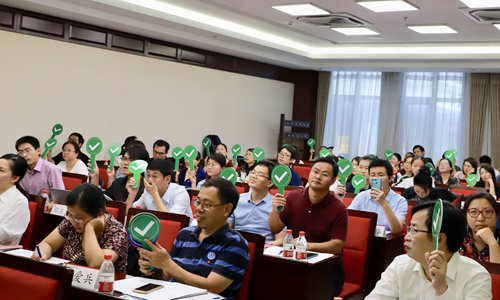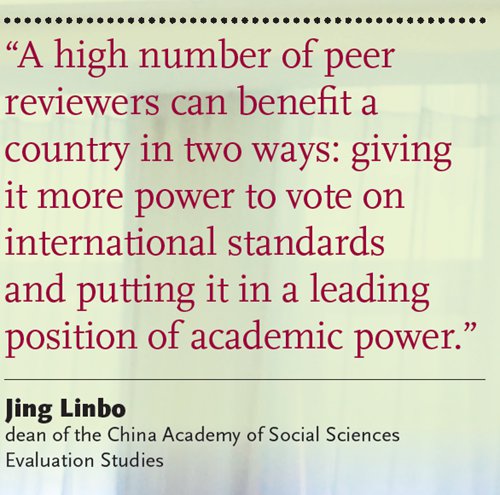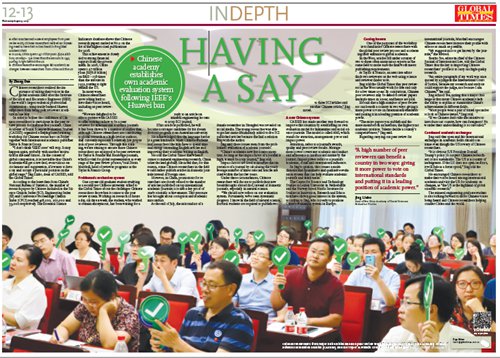HOME >> CHINA
Chinese scholars establish own academic evaluation system following IEEE’s Huawei ban
By Zhang Dan Source:Global Times Published: 2019/8/6 19:50:14
○ After IEEE banned Huawei employees from peer review work, Chinese researchers realized an increasing need to have their voices heard in the global academic field
○ In 2018, China spent 1.97 trillion yuan ($278.8 billion) on R&D - 138 times than the amount in 1991, putting it right behind the US
○ Chinese researcher encourages fair academic exchanges between researchers from China and the US

Chinese researchers realized the importance of raising their voices in the global academic field after the Institute of Electrical and Electronics Engineers (IEEE) - the world's largest technical professional organization - temporarily banned Huawei employees from being peer reviewers or editors in late May.
In order to bolster the confidence of Chinese researchers to participate in the peer review process for international journals, China Academy of Social Sciences Evaluation Studies (CASSES) organized a Beijing-based training workshop for Chinese researchers on Friday together with International academic publisher Taylor & Francis Group.
"I don't think 'IEEE cases' will stop. It may happen again, probably with another institution in the near future… In the context of global competition, it is inevitable that China's academia will get a raw deal, even vicious encirclement and suppression, if it wants to have a say and occupy a particular position on the global stage," Jing Linbo, dean of CASSES, told the Global Times.
According to the latest data from China's National Bureau of Statistics, the number of research papers by Chinese included in the Science Citation Index (SCI), Engineering Index (EI) and Conference Proceedings Citation Index (CPCI) reached 418,000, 266,000 and 59,000 respectively. The Essential Science Indicators database shows that Chinese research papers ranked at No.2 on the list of the highest cited publications for 2018.
This achievement is closely tied to strong financial support from the government. In 2018, China spent 1.97 trillion yuan ($278.8 billion) on R&D - 138 times than the amount in 1991, putting it right behind the US.
In many ways, Chinese researchers are working hard to have their voices heard, including as peer reviewers.
"We were delighted to be able to partner with CASSES to offer training in how to be a peer reviewer for international academic journals. It has been shown by a number of studies that, although Chinese researchers are contributing to global research at a high level as authors, they currently represent a relatively low proportion of peer reviewers. Through this training, we are aiming to ensure more Chinese researchers are equipped to be peer reviewers for Taylor & Francis and Routledge journals, which is vital for global representation at every stage of the peer review process,"said Diana Marshall, head of reviewer programs at the Taylor & Francis Group.
Problematic evaluation system
One 25-year-old graduate student studying at a second-tier Chinese university talked to the Global Times about the challenges Chinese researchers face when it comes to the peer review system. Working on research 12 hours a day, six days a week, the student, who wished to remain anonymous, has been waiting for a reply to an article on mineral engineering he sent to a top SCI journal.
If his article is published, he will become a stronger candidate for his dream doctoral program at an Australian university.
He acknowledged that the language barrier is a great hindrance. Many Chinese students and researchers like him have to spend time and energy on reading English articles and improving their academic writing in English.
He told the Global Times that when it comes to mineral engineering research, China takes the lead globally. He noted that, for this reason, some Chinese researchers in the field would rather publish articles in domestic journals instead of foreign ones.
However, in China, promotions for researchers are closely related to the number of articles published on top international academic journals; it is also a key proof of one's scientific achievements. This pressure has brought about corruption and academic misconduct.
At the end of July, the misconduct of a female researcher in Shanghai was revealed on social media. The young researcher was able to get her name fraudulently added to five SCI published articles because she had a relationship with the author.
Jing said these issues stem from the problematic evaluation of academic journals.
"China's academia now has a misconception: As long as the impact factor of a journal is high, it must be a top journal," Jing said.
Impact factors are used to measure the importance of a journal by calculating the yearly average number of times selected articles are cited within the last few years.
Under these circumstances, Chinese researchers will choose to publish their new breakthroughs abroad first, instead of domestic journals, especially in natural science.
"We should now reflect on our evaluation system. Fortunately, we've seen systematic progress. I know in the field of natural science, doctoral students are required to publish two to three SCI articles and another Chinese article," Jing noted.

A new Chinese system
CASSES has made another step forward to improve this situation by establishing its own evaluation model for humanities and social science journals. The model is called AMI, which stands for attraction, management power and impact power.
Attraction, refers to a journal's awards, quality and peer review results. Management power covers any academic misconduct and adherence to institutional norms by the journal. Impact power refers to a journal's academic, social and international influence.
In Jing's opinion, this creates a multi-dimensional quantitative and qualitative evaluation system that can help evaluate academic journals and think tanks.
The Centre for Science and Technology Studies at Leiden University in Netherlands and the Norway-based Nordic Institute for Studies in Innovation, Research and Education have shown great interest in the system, according to Jing, who is ready to promote China's evaluation system in Europe.
Getting known
One of the purposes of the workshop is to familiarize Chinese researchers with the global peer review process and accelerating their entrance to global academia.
In the West, articles fall under scrutiny of two to three often-anonymous experts in the same field to make sure the final work meets publishing requirements.
At Taylor & Francis, an associate editor finds two reviewers on the web using science and reviewer finder tools.
Jing told the Global Times that peer reviewers in the West usually work for free and only for a few times a year. By comparison, Chinese peer reviewers may be asked to review papers multiple times in a year, and hence are paid.
He said that a high number of peer reviewers can benefit a country in two ways: giving it more power to vote on international standards and putting it in a leading position of academic power.
"The more papers you publish and the more members in an institute, the higher your academic position. Talents decide a country's competitiveness," Jing said.
Regarding carrying out peer review for international journals, Marshall encourages Chinese researchers increase their profile with editors as much as possible.
"My suggestion is to get known by the journals," she advised.
Sienho Yee, editor-in-chief of the Chinese Journal of International Law, told the Global Times that the key to improving Chinese researchers' profile is to carry out high-quality research.
"An entire paragraph of my work was once quoted by a judge at the International Court of Justice, because my research and analysis could support the judge, not because I am Chinese," Yee said.
Jing echoed Yee, noting that a major challenge is that many Chinese academics lack the ability to explain or summarize China's achievements in different fields.
"Most people wear a pair of tinted spectacles to look at Chinese issues," Jing said.
"If we Chinese don't take the initiative to introduce our country, how can foreigners? No wonder their understanding is so one-sided."
Continued academic exchanges
Jing said that open and fair international exchanges in academic fields should continue even though the US is wary of Chinese researchers.
"It is obvious [US President Donald] Trump's policy [to suspect Chinese researchers] is not sustainable. The US is a country of immigrants. If the US does not open its doors, it will fade at a faster speed," Jing told the Global Times.
He encouraged Chinese researchers to make their voices heard among international academia and visit the US for academic exchanges, as "the US is the highland of global scientific research."
The mineral engineering graduate student is also looking forward to more Chinese voices being heard and Chinese researchers helping connect China and the world.

Newspaper headline: Having a say
○ In 2018, China spent 1.97 trillion yuan ($278.8 billion) on R&D - 138 times than the amount in 1991, putting it right behind the US
○ Chinese researcher encourages fair academic exchanges between researchers from China and the US

Chinese researchers from major universities attend a peer review workshop organized by the China Academy of Social Sciences Evaluation Studies (CASSES) and the Taylor & Francis Group on Friday in Beijing. Photo: Courtesy of CASSES
Chinese researchers realized the importance of raising their voices in the global academic field after the Institute of Electrical and Electronics Engineers (IEEE) - the world's largest technical professional organization - temporarily banned Huawei employees from being peer reviewers or editors in late May.
In order to bolster the confidence of Chinese researchers to participate in the peer review process for international journals, China Academy of Social Sciences Evaluation Studies (CASSES) organized a Beijing-based training workshop for Chinese researchers on Friday together with International academic publisher Taylor & Francis Group.
"I don't think 'IEEE cases' will stop. It may happen again, probably with another institution in the near future… In the context of global competition, it is inevitable that China's academia will get a raw deal, even vicious encirclement and suppression, if it wants to have a say and occupy a particular position on the global stage," Jing Linbo, dean of CASSES, told the Global Times.
According to the latest data from China's National Bureau of Statistics, the number of research papers by Chinese included in the Science Citation Index (SCI), Engineering Index (EI) and Conference Proceedings Citation Index (CPCI) reached 418,000, 266,000 and 59,000 respectively. The Essential Science Indicators database shows that Chinese research papers ranked at No.2 on the list of the highest cited publications for 2018.
This achievement is closely tied to strong financial support from the government. In 2018, China spent 1.97 trillion yuan ($278.8 billion) on R&D - 138 times than the amount in 1991, putting it right behind the US.
In many ways, Chinese researchers are working hard to have their voices heard, including as peer reviewers.
"We were delighted to be able to partner with CASSES to offer training in how to be a peer reviewer for international academic journals. It has been shown by a number of studies that, although Chinese researchers are contributing to global research at a high level as authors, they currently represent a relatively low proportion of peer reviewers. Through this training, we are aiming to ensure more Chinese researchers are equipped to be peer reviewers for Taylor & Francis and Routledge journals, which is vital for global representation at every stage of the peer review process,"said Diana Marshall, head of reviewer programs at the Taylor & Francis Group.
Problematic evaluation system
One 25-year-old graduate student studying at a second-tier Chinese university talked to the Global Times about the challenges Chinese researchers face when it comes to the peer review system. Working on research 12 hours a day, six days a week, the student, who wished to remain anonymous, has been waiting for a reply to an article on mineral engineering he sent to a top SCI journal.
If his article is published, he will become a stronger candidate for his dream doctoral program at an Australian university.
He acknowledged that the language barrier is a great hindrance. Many Chinese students and researchers like him have to spend time and energy on reading English articles and improving their academic writing in English.
He told the Global Times that when it comes to mineral engineering research, China takes the lead globally. He noted that, for this reason, some Chinese researchers in the field would rather publish articles in domestic journals instead of foreign ones.
However, in China, promotions for researchers are closely related to the number of articles published on top international academic journals; it is also a key proof of one's scientific achievements. This pressure has brought about corruption and academic misconduct.
At the end of July, the misconduct of a female researcher in Shanghai was revealed on social media. The young researcher was able to get her name fraudulently added to five SCI published articles because she had a relationship with the author.
Jing said these issues stem from the problematic evaluation of academic journals.
"China's academia now has a misconception: As long as the impact factor of a journal is high, it must be a top journal," Jing said.
Impact factors are used to measure the importance of a journal by calculating the yearly average number of times selected articles are cited within the last few years.
Under these circumstances, Chinese researchers will choose to publish their new breakthroughs abroad first, instead of domestic journals, especially in natural science.
"We should now reflect on our evaluation system. Fortunately, we've seen systematic progress. I know in the field of natural science, doctoral students are required to publish two to three SCI articles and another Chinese article," Jing noted.

A new Chinese system
CASSES has made another step forward to improve this situation by establishing its own evaluation model for humanities and social science journals. The model is called AMI, which stands for attraction, management power and impact power.
Attraction, refers to a journal's awards, quality and peer review results. Management power covers any academic misconduct and adherence to institutional norms by the journal. Impact power refers to a journal's academic, social and international influence.
In Jing's opinion, this creates a multi-dimensional quantitative and qualitative evaluation system that can help evaluate academic journals and think tanks.
The Centre for Science and Technology Studies at Leiden University in Netherlands and the Norway-based Nordic Institute for Studies in Innovation, Research and Education have shown great interest in the system, according to Jing, who is ready to promote China's evaluation system in Europe.
Getting known
One of the purposes of the workshop is to familiarize Chinese researchers with the global peer review process and accelerating their entrance to global academia.
In the West, articles fall under scrutiny of two to three often-anonymous experts in the same field to make sure the final work meets publishing requirements.
At Taylor & Francis, an associate editor finds two reviewers on the web using science and reviewer finder tools.
Jing told the Global Times that peer reviewers in the West usually work for free and only for a few times a year. By comparison, Chinese peer reviewers may be asked to review papers multiple times in a year, and hence are paid.
He said that a high number of peer reviewers can benefit a country in two ways: giving it more power to vote on international standards and putting it in a leading position of academic power.
"The more papers you publish and the more members in an institute, the higher your academic position. Talents decide a country's competitiveness," Jing said.
Regarding carrying out peer review for international journals, Marshall encourages Chinese researchers increase their profile with editors as much as possible.
"My suggestion is to get known by the journals," she advised.
Sienho Yee, editor-in-chief of the Chinese Journal of International Law, told the Global Times that the key to improving Chinese researchers' profile is to carry out high-quality research.
"An entire paragraph of my work was once quoted by a judge at the International Court of Justice, because my research and analysis could support the judge, not because I am Chinese," Yee said.
Jing echoed Yee, noting that a major challenge is that many Chinese academics lack the ability to explain or summarize China's achievements in different fields.
"Most people wear a pair of tinted spectacles to look at Chinese issues," Jing said.
"If we Chinese don't take the initiative to introduce our country, how can foreigners? No wonder their understanding is so one-sided."
Continued academic exchanges
Jing said that open and fair international exchanges in academic fields should continue even though the US is wary of Chinese researchers.
"It is obvious [US President Donald] Trump's policy [to suspect Chinese researchers] is not sustainable. The US is a country of immigrants. If the US does not open its doors, it will fade at a faster speed," Jing told the Global Times.
He encouraged Chinese researchers to make their voices heard among international academia and visit the US for academic exchanges, as "the US is the highland of global scientific research."
The mineral engineering graduate student is also looking forward to more Chinese voices being heard and Chinese researchers helping connect China and the world.

Newspaper headline: Having a say
RELATED ARTICLES:
Posted in: IN-DEPTH